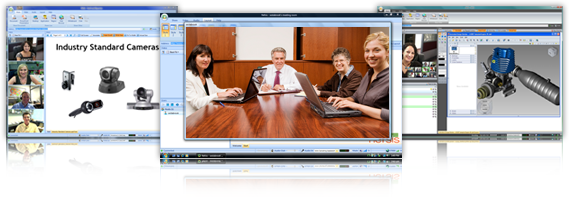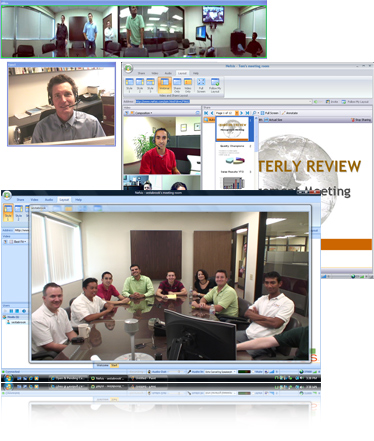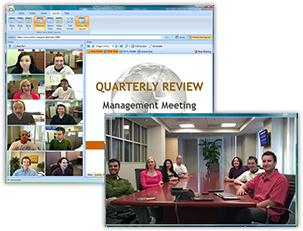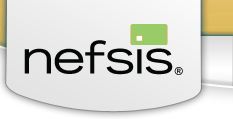- Video Conferencing Home
- ::
- Video Conferencing Services
- ::
- Telepresence

Nefsis Commentary
March 31, 2009 — The following commentary is provided by Nefsis regarding telepresence versus video conferencing using widely available, industry standard audio/video peripherals.
Introduction to Telepresence
According to Wikipedia, "Telepresence refers to a set of technologies which allow a person to feel as if they were present, to give the appearance that they were present, or to have an effect, at a location other than their true location. Telepresence requires that the senses of the user, or users, are provided with such stimuli as to give the feeling of being in that other location."
Life-sized images, eye contact, and spatial sound are examples of the "stimuli" that a telepresence system delivers. In terms of actual technology, there are very few differences between a telepresence system and traditional video conferencing. Both systems utilize the same compression, network, echo cancellation and optical technologies. The primary difference between a telepresence system and a traditional video conferencing system is in how the systems are installed and configured.
Providing telepresence "stimuli" requires a permanent, dedicated installation. A typical telepresence installation is more of a studio than it is a conference room. Cameras must be positioned in such a way as to present life-sized images of people, while establishing full eye contact between remote participants. Each studio is custom tailored to reduce each video conferencing camera gaze angle. The position of the meeting participants must be precise. It also limits the number of participants physically located in a room.
For example, the Cisco Telepresence 3000 supports three 65 inch screens, two people per screen, for a total of 6 people per location. Other key factors include lighting and furniture, which are provided as components of the Cisco Telepresence system.
One of the most important components of a telepresence system is bandwidth. Telepresence requires substantial bandwidth, a minimum of 2 to 3 mbps of up and downlink bandwidth per screen is required for the full immersive effect. Virtually all telepresence studios us dedicated Internet access as any drop below the minimum will result in audio jitter and latency destroying the immersive experience.
Many organizations are intrigued by the capabilities of telepresence systems. However, the initial cost of the conferencing studio and the recurring network fees put these systems out of the reach of all but the largest and wealthiest companies. There are also organizations that do not have the space to dedicate an entire room to telepresence. Or, if they have the space, the rooms may lack the required dimensions.
Nefsis Provides the Perfect Alternative to Telepresence
With Nefsis, online meeting participants can enjoy high definition (HD) video conferencing at a fraction of the cost of a typical telepresence system. The Nefsis cloud ensures high quality transmission of your conference through a standard Internet connection, resulting in even further cost saving. A 1 mbps line for HD video conferencing is all you need. You can operate with much lower bandwidth if standard definition is sufficient for your needs (or for other participants that only need SD or webcam input).
 |
The screenshots at left show mixed Roundtable,
webcams, standard definition, and high-definition video
inputs — all in the same video conference session.
Every video input shown is from a standard video peripheral, even the
Roundtable
camera uses a USB interface. Among the disadvantages of telepresnce studios are proprietary hardware, and limited reach to same-brand, fixed-site locations. Another disadvantage is the lack of data sharing features for working online meetings. |
Live data sharing is an area where most telepresence systems fall short. The feedback that we receive from Nefsis customers tells us that most meetings center around the collaboration or presentation of information. Nefsis provides PowerPoint, document, application, and desktop sharing, along with white boarding and remote control, all of which is a seamless part the online videoconference.
Nefsis will also run on desktop computers virtually anywhere in the world there Internet access, including conference rooms and training facilities. Small offices, home offices or travelling executives easily connect into meetings, and have all of the same sharing capabilities as those in the main conference room. We not only interface with a desktop application, we are the desktop application.

Easy to Start, Easy to Use
If you are looking to reduce your travel budget, but are skeptical about the amount of time it takes to get a return on your investment, check out Nefsis. Our prices start at $350 per month, including HD support, multiparty video conferencing, worldwide reach to any desktop (not just fixed-site installations), and all live data sharing features.
Commentary Archive
January, 2007 — The following commentary is provided by Nefsis regarding recent industry announcements, articles and news surrounding the Cisco entry into the budding telepresence market.
Cisco Follows LifeSize & HP Halo
Of course Cisco and video conferencing are nothing new. Cisco has several product lines dedicated to this application, including executive VC station hardware, and their IP/VC products such as video multiplexers (MUXs). What's noteworthy is the latest major push by joining HP Halo, LifeSize and others in redefining the high-end of the videoconference market.
Last to market, but not to be outdone, Cisco announcements promote high-fidelity surround sound, large flat-panel displays, full-screen video, real-time response and a fully immersive, studio-quality conferencing environment. In a surprise move, the details of some announcements proudly mention Cisco homegrown, non-industry standard components.
The commentary below explores this new product line and where it fits with respect to
the industry at large, competitors, alternatives, and the latest generation
IP-based video conferencing software products such as those sold by Nefsis.
What is HD Telepresence?
Telepresence can be loosely described as fixed-site video conferencing hardware on steroids. Of course, high-definition (HD) is an important element. But the decisive quality that sets telepresence apart is studio quality "immersion." The best telepresence products include a very precise, physical build-out of the conference room very much like a movie or sound stage. This includes camera, microphone and speaker placement, so that gaze angles are reduced, and participants enjoy an actual-size display of all participants and full spectrum, surround-sound-like audio. Indeed, these facilities are often referred to as studios by vendors and the employees that are fortunate enough to use them.Who is Cinematic Telepresence For? How Much Does it Cost?
Telepresence systems are very expensive, it is not uncommon to find pricing in the range of $100,000 to $250,000 for each studio, plus monthly fees of $6,000 per site or more for dedicated bandwidth and on-going services.
The characteristics of these systems — studio build-out, extreme price, immersive
quality — are defining an entirely new, uber high-end marketplace comprised of
record labels, film studios, oil company headquarters and so on. And at these
prices, yes, they really do deliver a cinematic experience. Who services
this new market? Which product is best? A good comparison would be to research
and physically experience Cisco Telepresence (IPVC), HP Halo, and LifeSize, and see
which one is better. All of these competitors are defining the new telepresence
market segment.
Market Overview
With new telepresence systems creating a new high-end market segment, and IP video adding a whole new set of alternatives for small-to-medium business, the video conferencing (VC) market is enjoying a renaissance of sorts.The general industry wisdom is web and video conferencing applications are going up across the board. Often cited reasons include the ever increasing complexity of products and services that require better visual communications tools, decentralization, globalization, telecommuting and other factors that drive multi-location team meetings. Add to this increasing travel costs, travel restrictions, and time delays, and it's no wonder the industry is experiencing a growth spurt.
At the risk of over-simplification, Nefsis sees the general VC business markets morphing along the following lines:
Telepresence – the new high end
- Description: fixed-Site, complete audio/video studio build-out, requires dedicated, high-bandwidth network routes (DS3+)
- Pricing: extreme, easily $100,000/site and up
- Pros: immersive quality, ideal for specialty, cost-is-no-object applications
- Cons: studio-to-studio only, no ad hoc conferencing
- Examples: Cisco HD Telepresence, HP Halo, LifeSize, and other competitors
Boardroom video conferencing hardware
- Description: fixed site, video conferencing hardware, dedicated network routes
- Pricing: complex, generally $50,000 and up including video MCUs/MUXs and all hardware components required
- Pros: ideal for boardroom video conferencing
- Cons: cost, complexity, conferencing limited to like facilities
- Examples: Tandberg, Polycom, and other alternatives
- Description: desktop IP-based video conferencing software and software-as-a-service
- Pricing: depends on vendor
- Pros: ideal for desktop video conferencing, low cost, uses browsers, desktop PCs and depending on vendor, proprietary or PC-based audio/video peripherals
- Cons: depends on existing networks for video quality; products with peer-to-peer, classroom, and local area network legacy struggle with firewall/proxy traversal (e.g., NetMeeting)
- Examples: Nefsis, see below, others
SPECIAL EXAMPLE: Nefsis software
Nefsis is one of the fastest growing web and video conferencing products for business. It is an excellent example of the latest IP-based conferencing solutions.
- Description: secure, browser-based web, VoIP, and multiparty video conferencing; runs over existing public and private networks
- Pricing: low cost, simple fixed-fee pricing (software or online service)
- Pros: excellent ad hoc conferencing with virtually any business PC worldwide (firewall and proxy traversal); uses readily available audio and video peripherals; secure SSL3/TLS conferencing, can even use the customer's certificate and/or public key infrastructure; complete web conferencing/collaboration feature set; simple pricing
- Cons: depends on existing network for video quality, some sites may be limited to low- and medium-quality video (note: software automatically adjusts to mixed-speed connections)
ASP, Telco, and OEM
These specialized market segments are beyond the scope of this
commentary. A key issue here is whether the application is for
business-to-business or consumer communications. Commercial products
require security, firewall and proxy traversal, and multiparty
conferencing such as that provided by Nefsis; while consumer
applications can live with no security, 2-party limits and peer-to-peer
connections (which do not work between business users behind separate
firewalls).
Cisco Telepresence & Market Summary
The recent Cisco entree into the emerging HD telepresence market is wonderful. Cisco's market presence and the quality of their offering are galvanizing attention, creating more awareness and possibly among the many factors spurring real market growth industry-wide. We see the future of telepresence as bright. After all, who doesn't want to take a spin on the holodeck? As to the large expense, generally over $100,000 per facility, and physical conference room build-out, that's all part of telepresence studio mystique and the select market for this new class of product. As to the oft-cited criticism — homegrown, non-industry-standard components — we disagree. For fixed-sites with dedicated network routes, industry standards don't matter. There is no claim to data interchange. Moreover, at these prices all hardware, software and on-going services are managed by the vendor anyway. They are paid to manage that complexity for you and provide a turnkey studio.
We view the latest telepresence products and services as battling it out with traditional video conferencing hardware vendors. The latter will get the brunt of any overlap between telepresence and traditional video conferencing hardware. It won't matter much, because the entire market is growing, and much like email did not make FAX machines go away, we'll see VC hardware sitting in boardrooms for a long time.
As an industry participant, we are most excited about the growth at the other end of the market spectrum: desktop IP-based video conferencing systems such as our own Nefsis product. These systems are much more appropriate for the small-to-medium size enterprise, affectionately known as the “big end†of the market. The advantages of browser-based, ad hoc conferencing to any desktop worldwide, over existing networks and use of standard PC audio/video peripherals, all at reasonable fixed prices are very compelling (to the SME market) versus all the other alternatives described above.
We are indeed enjoying the recent telepresence announcements, but we lament so few people will benefit. With the power of Moore's law and Pentium processors, IP-based video conferencing software rivals traditional boardroom hardware — and the latest generation of IP conferencing technology will take these benefits to thousands of installations and millions of people worldwide.
For those researching video conferencing solutions of any kind, we encourage you to look at software-based, IP video solutions too. If you have never experienced a full-screen IP-based video conferencing session, you might be very surprised.
Schedule a Live Demo
Click here to schedule a Live Demo and see Nefsis multiparty video conferencing for yourself, right from your own desktop!

